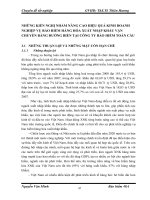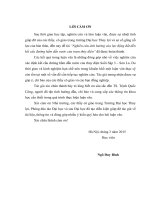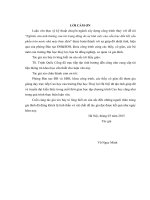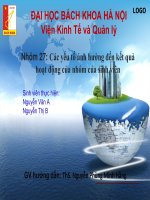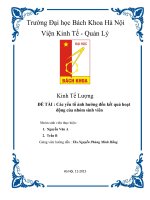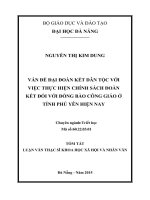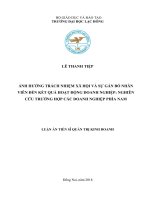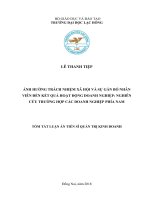Nghiên cứu ảnh hưởng của sáng tạo của nhân viên đến kết quả hoạt động kinh doanh của doanh nghiệp ở đồng bằng sông cửu long TT TIENG ANH
Bạn đang xem bản rút gọn của tài liệu. Xem và tải ngay bản đầy đủ của tài liệu tại đây (671.27 KB, 29 trang )
MINISTRY OF EDUCATION AND TRAINING
CAN THO UNIVERSITY
SUMMARY OF THESIS
MAJOR OF BUSINESS ADMINISTRATION
Code of major: 62.34.01.02
NGUYEN THANH TU
RESEARCH ON THE INFLUENCE OF EMPLOYEE’S
CREATIVITY ON BUSINESS PERFORMANCE
OF ENTERPRISES IN MEKONG DELTA
Can Tho, 01/2022
THE THESIS WAS COMPLETED
IN CAN THO UNIVERSITY
Supervisor: Assoc. Prof. Dr. Nguyen Huu Đang – Can Tho University
Co- Supervisor: Dr. Tran Thanh Liem - Can Tho College
The thesis will be defended at the college-level dissertation council
Meeting at ……………………………………………...................
At ……………….., ……………. 2021.
Reviewer 1 :…………………………………………….…
Reviewer 2:…………………………………………….…
Reviewer 3: ……………………………………………….
This thesis can be found at the library:
Learning Resource Center, Can Tho University.
National Library of Vietnam.
PUBLICATIONS
1. Nguyen Thanh Tu and Nguyen Huu Đang (2018). Recognizing the
creativity of employees in large enterprises in the Mekong Delta. Asia-Pacific
Economic Review, No. 153, March 2018, page 36-38.
2. Nguyen Thanh Tu and Nguyen Huu Đang (2018). Factors affecting
employee creativity in large enterprises in the Mekong Delta. Asia-Pacific
Economic Review, No. end of May 2018, page 13-15.
3. Nguyen Thanh Tu and Nguyen Huu Đang (2018). The influence of
creativity on business results of large enterprises in the Mekong Delta. Banking
Technology Magazine, No. 152, November 2018, page 105-110.
4. Nguyen Thanh Tu and Nguyen Huu Đang and Tran Thanh Liem
(2019). Measuring business results using a subjective scale: The case of large
enterprises in the Mekong Delta. Asia Banking and Economic Review, No. 160,
July 2019, page 60.
CHAPTER 1: INTRODUCTION
1.1 RESEARCH PROBLEMS
The global competitive environment has posed challenges that force
managers to constantly seek innovation in all their activities (Andriopoulos,
2001). Lin and Liu (2012) have summarized innovation as an important factor
providing a sustainable competitive advantage that organizations can use to
cope with the constantly changing business environment. Amabile (1996)
believes that all innovation comes from employees' creative ideas, so managers
realize that it is necessary to encourage and promote creativity so that
employees can make valuable contributions for the business. There has been
much evidence that employees' creativity contributes to innovation, efficiency
and organizational survival (Bui Thi Thanh, 2014). Creativity is important to
organizations because the contributions of creativity not only help organizations
become more efficient, respond better to opportunities, make organizations
more resilient to change, grow and develop to compete in the global market (Bui
Thi Thanh, 2014). Therefore, promoting the creativity of employees is one of
the decisive factors for the success of the organization (Walton, 2003).
So what are the essential elements of individual creativity? What factors
influence creativity? How does creativity affect business results? These are big
and very important questions that need to be answered satisfactorily for business
managers. Identifying these essential factors will help managers improve their
human resource organization, encourage and promote creativity, and improve
the competitiveness of their businesses.
Enterprises across the country in general, as well as large enterprises in the
Mekong Delta in particular, are having to change to match the increasing
competition due to the transition of the economy to a base economy. The market
mechanism is becoming more and more complete, as well as the trend of
international integration deepening. In the context that the 4.0 revolution is
taking place strongly, requiring the ability to adapt and catch up with new
technology trends, many large enterprises and corporations have chosen to
cooperate with start-ups to take advantage of new technologies, to utilize brain
resources and promote growth (VNR, 2019). The Mekong Delta is currently in
the stage of accelerating industrialization, modernization and international
integration, so the issue of improving the quality of human resources needs to
be prioritized in the direction of improving the quality of investment for
training, diversifying types of training and promoting international cooperation
in human resource training, etc. With the traditional characteristics of
industriousness, tolerance, hard work, self-reliance, dynamism , creativity of the
Mekong Delta people, a latent creative capacity that managers in this region
1
need to know how to stimulate, grasp what factors to arouse and promote
creativity and passion for creativity (Pham Van Bua, 2010), contributing to
business and economic development in this region.
Large enterprises (according to Decree 39/2018/ND-CP dated November
3, 2018 detailing a number of articles of the Law on supporting small and
medium-sized enterprises, replacing Decree No. 56/2009/ND-CP dated June 30,
2009 on supporting the development of small and medium-sized enterprises)
has strengths in capital, human resources, access to advanced science and
technology, large enterprises are ready to receive challenges, and seize the
opportunities of the times, must break down barriers, improve the quality of
human resources and technology, create an environment that promotes
creativity to perfect and enhance their competitiveness. Besides, large
enterprises are the foundation for start-up businesses, which is a large consumer
for these businesses. Startups can only scale through model-building support
from large enterprises. Moreover, large enterprises and large corporations can
also become partners of start-ups, acting as the framework of the national
economy, as breakthroughs to help goods and services of a country successfully
penetrating the world market (Communist Party of Vietnam, 2019). Large
enterprises have a high demand for input resources such as capital, labor,
infrastructure, etc., so they have a huge spillover effect on other sectors of the
economy. Large enterprises are the support for small and medium enterprises,
where they consume intermediate products and services provided by small and
medium enterprises to form large products (VNR, 2017).
Although employee creativity in enterprises plays a very important role for
businesses, it helps to increase business efficiency (Lumpkin and Dess, 1996;
Hult, Hurley and Knight, 2004; Kunz and Schaaf, 2011;). ) but studies have only
been conducted in developed countries (Calantone, Cavusgil and Zhao, 2002;
Lee, Lee, Young, and Jo, 2011), very few studies have been conducted in
Vietnam (Bui Thi Thanh, 2014). The current status of domestic research on
factors that positively affect creativity and the influence of creativity on
business performance of enterprises is still open (Bui Thi Thanh, 2014). A few
previous studies only focused on building models of factors affecting creativity,
or many foreign studies only stopped at building regression models on the
influence of creativity on business performance of the enterprise, or the
influence of creativity on innovation in the enterprise. Previous studies have not
built a unified theoretical model including factors affecting creativity, and
creativity affecting business performance. This is a gap that is addressed in this
study.
Enterprises across the country in general and in the Mekong Delta in
particular have not really had a satisfactory solution to encourage and promote
2
the creativity of their employees to enhance their competitiveness. Large
enterprises with capital and human resources are ready to invest in innovation
of production technology, boldly adjust technical lines to improve production
efficiency, ready to create an environment that promotes creativity for
employees (Calantone et al., 2002). In contrast, small and medium-sized
enterprises often operate in the family business model, so the production
technology is the original technology model, keeping the technology of the
manufacturer, these enterprises are not bold enough to improve and innovate
the production line to match the current production situation. With the
traditional characteristics of industriousness, tolerance, hard work, self-reliance,
self-reliance, dynamism and creativity of the Mekong Delta people, a latent
creative capacity that managers in this region have need to know how to arouse,
promote creativity and creative passion. The problem is how to promote and
create a creative and innovative environment to create value for large
enterprises in the Mekong Delta. To answer this question, it is necessary to have
a specific research model on creativity and its influence on business
performance of enterprises.
Therefore, this study was conducted to assess the influence of employees'
creativity on the business performance of large enterprises in the Mekong Delta
through the thesis Research on the influence of employees' creativity on
business performance of enterprises in the Mekong Delta
1.2 OBJECTIVES
1.2.1 Overall objective
The overall goal of the thesis is to study the theoretical and practical basis
of employee creativity and the influence of employee creativity on business
results of large enterprises in the Mekong Delta; thereby proposing management
implications to promote employee creativity and improve business results for
enterprises.
1.2.2 Specific objectives
Specific objectives 1: Identifying factors affecting employee creativity in
large enterprises in the Mekong Delta.
Specific objectives 2: Measuring the impact of employee creativity on
business performance of large enterprises in the Mekong Delta.
Specific objectives 3: Propose some managerial implications to promote
employee creativity, and improve business performance in large enterprises in
the Mekong Delta.
1.3 RESEARCH QUESTION
- What factors affect the creativity of employees in large enterprises in the
Mekong Delta?
3
- How does the creativity of employees in large enterprises in the Mekong
Delta affect business results?
- What management implications are needed to promote employee
creativity and improve business results for large enterprises in the Mekong
Delta?
1.4 RESEARCH SCOPE AND METHODOLOGY
1.4.1 Research subjects
The research object of the thesis is the factors affecting the creativity of
employees, and the influence of employees' creativity on the business
performance of large enterprises in the Mekong Delta.
1.4.2 Respondents
The survey subjects of the thesis are employees working in departments in
large enterprises in the Mekong Delta, they are frontline employees, often in
direct contact with customers, partners, suppliers. ,.. should be knowledgeable
about the development situation as well as the working environment of the
enterprise.
1.4.3 Research space
The study was conducted at large enterprises in the Mekong Delta.
1.4.4 Research time
Time of secondary data: Secondary data is collected by the author from
the financial statements of large enterprises in the Mekong Delta over the years
2017, 2018 and 2019.
Time to conduct primary data survey: The study uses primary data from
survey results, direct surveys of respondents who are departmental staff
working in departments in a number of large enterprises in the Mekong Delta.
The survey period was from May 2019 to May 2020.
1.4.5 Research Methods
The thesis uses data analysis methods including descriptive statistics,
Cronback's Alpha test, exploratory factor analysis (EFA), confirmatory factor
analysis (CFA), and Structural Structural Modeling (SEM).
1.5 MEANINGS AND FINDINGS OF RESEARCH
Scientific significance
In general, domestic and foreign studies are still conducted sporadically,
only studying the factors affecting innovation, or the impact of innovation on
business performance of enterprises, or studying the effects of innovation on
business performance; or influence of creativity on enterprise innovation. This
study has built a general model of the factors that promote creativity and the
impact of creativity on business performance of enterprises. Research has
4
applied and developed measurement scales on factors that promote creativity,
developed a business performance measurement scale using Vankatraman's
(1987) perceived rating scale to measure the results for businesses.
The research model on factors affecting employee's creativity has the
appropriateness of the model reaching 88.20%, showing that the model of
factors is more comprehensive than the research models in and abroad before,
such as the research model on factors affecting creativity of employees in the
bank by Bui Thi Thanh (2014), the correlation in the model is only 57.80%;
Research model of Solmaz and Subramaniam (2013) on employee's creative
behavior in Malaysian enterprises only reached a correlation of 60.80%;
Research model of Hsu and Hsiu-Ju (2013) on factors affecting employee
creativity in garment enterprises in Taiwan is correlated at 57.60%.
Research results on the influence of employees' creativity on business
performance results have a correlation coefficient in the model of 76.80%,
showing the variability of the business performance factor are explained
76.80% from employees' creativity. The research results of the model have a
high correlation compared to some previous studies on the model of factors
affecting business performance of enterprises such as the research model of
Alvaro et. al. (2011). ) has a 75.70% correlation; the research model of Masood
et. al. (2013) on the influence of employee creativity on business performance
of Pakistan’s banks has a correlation coefficient in the model of only 64%.
Practical significance
The research results serve as a foundation to help large enterprises in the
Mekong Delta create an environment that promotes creativity for their
employees, selects personnel in recruitment, and assigns personnel to different
departments requires the high of creativity, and helping to improve the business
performance of the business. On the other hand, the research results are also the
basis for further researchers when studying the business performance of
enterprises in the absence of access to business data.
1.6 STRUCTURE OF THESIS
The thesis is organized into 5 chapters.
Chapter 1: Introduction. This chapter presents the research problem,
objectives, questions, research object and scope as well as the layout of the
thesis.
Chapter 2: Theoretical basis and research model. Chapter 2 describes
the theoretical basis as a basis for carrying out the research thesis through a
literature review on the research on factors affecting creativity, the influence of
creativity on business performance. From there, there is an approach to
5
measuring creativity scales, measuring factors affecting creativity, and
measuring business performance.
Chapter 3: Research Design. Chapter 3 outlines the measurement scales,
concepts in the theoretical model, research design and proposed model for the
thesis. Research design includes contents about research framework, sample
size, data collection process, data analysis techniques, research methods,
research model. Preliminary research is also discussed in this chapter 3.
Chapter 4: Research results. Chapter 4 analyzes the factors affecting
employee creativity in large enterprises in the Mekong Delta, Cronback's Alpha
test, exploratory factor analysis (EFA), confirmatory factor analysis (CFA),
evaluate the suitability of the theoretical model by Structural Equation
Modeling (SEM), discuss research results, analyze multi-group structure.
Chapter 5: Conclusions and implications for governance. Chapter 5
summarizes the significant findings of the study and proposes some managerial
implications for large enterprises in the Mekong Delta to create an environment
that promotes creativity and improves business performance. Finally, the thesis
highlights limitations and suggestions for future research directions.
6
CHAPTER 2: THEORETICAL BASIS AND RESEARCH MODEL
2.1 THEORETICAL BASIS
2.1.1 Concepts
Creativity: Creativity is coming up with ideas, tangible or intangible
products, processes, jobs, etc. that are new and useful, or improve existing ones
in order to better solve problems in working.
Employee’s creativity: The creativity of employees in the organization is
a form of behavior that is influenced by many factors from the inside of the
employee, such as motivation, knowledge, skills, way of thinking, working to
external environmental factors such as support from the organization,
encouragement of the organization.
Intrinsic Motivation: Intrinsic motivation of employees in the
organization is the work motivation, the desire and willingness of employees to
increase efforts towards the achievement of organizational goals.
Working environment: The working environment includes elements of
corporate culture and leadership style. It is the encouragement and support of
the organization; the reception and evaluation of employees' creative ideas
respectfully and fairly; organize to encourage employees to work in groups; and
colleagues easily share knowledge at work.
Self-efficacy: Self-control at work is being confident in generating new
ideas, being confident in their ability to solve problems creatively, being able to
develop ideas better than others, being confident in your work. finding new
ways to solve problems who are trained in creative problem solving skills.
Creativive self-efficacy: Creative selt-efficacy manifests itself when
employees accumulate a wealth of related creative knowledge and skills
(Amabile, 1988). Amabile (1988) also believes that employees who have a lot
of experience in creative activities, or an environment with creative
characteristics, will have more and more autonomy in creativity.
Creative cognitive style: A person with a creative thinking style is
someone who has a lot of creative ideas, who likes work that makes them think
in a creative way, who is very creative, and who loves to do the job in new ways.
Firm performance: Business performance is measured by financial
indicators such as sales growth, profit growth, market share growth and cost
savings.
Big firm: Decree No. 39/2018/ND-CP dated March 11, 2018 detailing a
number of articles of the Law on supporting small and medium-sized
enterprises, stipulating each field, based on the number of employees
7
participating in social insurance. annual average, and revenue or capital source
(where revenue is prioritized) to classify business size. For large enterprises, the
assessment is based on two main criteria, which are:
- For agriculture, forestry, fishery, industry, and construction enterprises,
which have an average annual number of employees participating in social
insurance of 200 or more, and total annual revenue over 100 billion.
- For commercial and service enterprises, which are enterprises with an
average annual number of employees participating in social insurance of 100 or
more, and enterprises with a total annual turnover of over 100 billion VND.
2.1.2 Background theories of creativity
2.1.2.1 Approach trends
There are two main approaches to creativity applied by researchers.
Gough’ s Traditional approach theory
Gough (1979) developed a scale to identify creativity through creative
personality traits ACL/CPS30 (adjective check list/characteristic personal
scale). ACL/CPS30 was inherited and developed by many later studies to
identify creative individual characteristics.
New theory approach
a) Amabile's composition theory of creativity
Amabile has built a theoretical basis on human creativity in organizations
and the relationship between creativity and the environment and innovation.
Accordingly, creativity is influenced by both personal and environmental
factors. Amabile's famous model is the component model of creativity which
includes (i) relevant skills and knowledge; (ii) related creative process; and (ii)
Motivation.
Expertise or
Domainrelevant skill
Creativity skill
or Creativity
relevant process
Creativity
Task motivation
Source: Amabile (1996)
Figure 2: Amabile's model of innovative components (1996)
8
b) Creativity theory of Woodman
Woodman developed the theory of employee creativity in organizations.
Woodman analyzed creativity into different levels, thereby analyzing the
interaction between the levels as well as the environmental factors affecting
each level.
The objective of this study is to build a model of factors that promote
employee creativity, and the influence of employee creativity on business
performance of the enterprise, so the author relies on Amabile's approach
theoretical framework serves as the theoretical framework for this study.
2.2 LITERATURE REVIEW
2.2.1 Factors that promote creativity
The topic of creativity has gained a lot of attention in recent decades.
Studies by many authors around the world have analyzed many aspects related
to employee creativity as present in Table 2.1.
Table 2.1: Summary of literature review
No.
1
Factor
Intrinsic
motivation
2
Self-efficacy
3
Creativive
self-efficacy
4
Creative
cognitive
style
5
Working
environment
Source
Hackman and Oldham (1980); Oldham and Cummings
(1996); Tierney, Farmer, và George (1999); Zhou and
George (2001); Madjar et. al. (2002); Shalley et. al.
(2004); Eder (2007); Eder and Sawyer (2008); Carmen
et. al. (2008); Bui Thi Thanh (2014); Ha Nam Khanh
Giao and Nguyen Hoang Vinh (2015).
Eder (2007); Eder and Sawyer (2008); Bui Thi Thanh
(2014); Sarac, Efil and Mehmet (2014); Ha Nam Khanh
Giao and Nguyen Hoang Vinh (2015).
Amabile (1997); Eder (2007); Eder and Sawyer (2008);
Houghton and Diliello (2009); Bui Thi Thanh (2014);
Sarac, Efil and Mehmet (2014); Ha Nam Khanh Giao and
Nguyen Hoang Vinh (2015).
Hackman and Oldham (1980); Oldham and Cummings
(1996); Tierney, Farmer, and George (1999); Zhou and
George (2001); Madjar et. al. (2002); Shalley et. al.
(2004); Eder (2007); Eder and Sawyer (2008); Carmen
et. al. (2008); Bui Thi Thanh (2014); Ha Nam Khanh
Giao and Nguyen Hoang Vinh (2015).
Hackman and Oldham (1980); Woodman et. al. (1993);
Oldham and Cummings (1996); Tierney, Farmer, and
George (1999); Zhou and George (2001); Madjar et. al.
(2002); Shalley et. al. (2004); Houghton and Diliello
(2009); Bui Thi Thanh (2014).
9
Đo Minh Khue (1989); Shalley (1991); Woodman,
Sawyer and Griffin (1993); Zhou and Shalley (2003);
Egan (2005); Eder (2007); Eder and Sawyer (2008);
Murat et. al. (2012); Nguyen Thi Duc, Nguyen and Le
Phuoc Luong (2017).
Source: Summary from the author's document review 2019
2.2.2 Measuring business performance of enterprises
Studies often refer to indicators measuring business performance of
enterprises through subjective indicators and objective indicators. The studies
applying two measurement methods are presented in Table 2.2.
6
Other factors
Table 2.2: Studies measuring business performance
No.
1
Indicator
Onjective
indicators
Source
Hax and Majluf (1984); Atkinson, Waterhouse,
and Wells (1997); Tangen (2005); Nguyen and Ng
(2007); Agustinus and Rachmadi (2008); Wu and
Lin (2010); Khatab and Masood (2011); Ong and
Heng (2011); Nguyen Quoc Nghi and Mai Van
Nam (2011); Saeedi and Gull (2013); Keh Đoan
Ngoc Phuc (2014); Le Thi Thu Ha (2018).
2
Subjective
Vankatraman
(1988);
Venkatraman
and
indicators
Ramanujam (1989); Barney (1991); Kaplan and
Norton (1992); Richard (2000); Liavigovas et. al.
(2010); Blazek (2008); Masood, Malik, Hasnain,
Faiz and Abbas (2013); Atalay, Anafarta, and
Sarvan (2013); Thiaku et. al. (2016); Le Thi Thu
Ha (2018).
Source: Summary from the author's document review 2019
2.2.3 Influence of creativity on business results of enterprises
Many studies such as George and Zhou (2001); Tierney, Farmer and Graen
(1999); McLaughlin and Harris (1997); Jong and Hartog (2007); Hellman and
Thiele (2009); Tushman and Orielly (1997); Martins and Terblunche (2003)
also concluded that employee creativity is one of the most important
management principles, one of the important contributing factors to the success
of the organization.
2.3 ASSESSMENT OF LITERATURE REVIEW
2.3.1 Genergal assessment
The previous studies only to build models of factors affecting creativity,
or models of the influence of creativity on business performance of enterprises,
or creative influences on innovation. There has not been a study to build a
general model to test the factors affecting creativity to help businesses create an
10
environment that promotes creativity for their employees, and the influence
between creativity on business results of the firms in order to enhance
competitiveness by promoting the creativity of employees.
2.3.2 Gaps of previous studies
Theoretical gap: Many domestic and foreign studies only focus on
modeling factors affecting innovation, and consider creativity as an
intermediary factor. Previous studies have not built a general model of the
factors affecting creativity and the influence of creativity on business
performance of enterprises. This is a theoretical gap that this study fills.
Practicality gap: Although employee creativity in enterprises plays a very
important role for businesses, helping to improve business performance, the
research is only conducted in developed countries (Calantone et. al., 2002; Kunz
et. al., 2011), very few studies have been conducted in Vietnam. Moreover, the
current status of domestic research on factors that positively affect creativity
and the influence of creativity on business performance of enterprises is still
open (Bui Thi Thanh, 2014). This study, on the one hand, inherits from previous
research results, has been adjusted to suit specific research subjects, the author
also overcomes the gaps of previous studies by building a model of factors
promoting creativity and its impact on business performance of large enterprises
in the Mekong Delta.
2.4 THEORIES AND RESEARCH MODEL
From the overview of Amabile's theoretical model of creativity (1996),
along with inheriting and overcoming the gaps of previous studies, the author
builds a research model presented as Figure 2.2.
Source: Author construction, 2019.
Figure 2.1: The research model
11
CHAPTER 3: RESEARCH DESIGN
3.1 RESEARCH PROCESS
Source: Author construction, 2019.
Figure 3.1: The research process
3.2 RESEARCH METHODOLOGY
3.2.1 Qualitative research method
In this study, the author uses exploratory qualitative research method by
hand-to-hand discussion with experts with extensive experience in working as
well as in business management in the Mekong Delta to supplement and edit
the questionare.
3.2.2 Quantitative research method
3.2.2.1 Method of data collection
a) Secondary data collection
The thesis uses secondary data on socio-economic, political, legal, etc. of
the Mekong Delta through the Statistical Yearbook of Vietnam, the Statistical
Yearbook of the provinces in the Mekong Delta from 2016 to 2019, from the
Central Institute for Economic Management and Research, the Socio-Economic
Research Institute of the Mekong Delta, the Vietnam Chamber of Commerce
and Industry (VCCI), the Chamber of Commerce and Industry of the Mekong
12
Delta Provinces, the Association E-commerce, Vietnam Economic White Paper
2019.
b) Primary data collection
Primary data was collected through a questionnaire designed by the author
by inheriting and developing the questionnaires of previous studies. The survey
subjects of the thesis are employees working in departments in large enterprises
in the Mekong Delta, most of them have been trained from college or higher,
have the ability to research and creative, are frontline people, often in direct
contact with customers, partners, suppliers, etc. should be knowledgeable about
the development situation of the business.
3.2.2.2 Method of determining sample size
Based on the sampling method, along with the distribution of the number
of large enterprises to interview its employee in the Mekong Delta (73
enterprises), the author conducted interviews with employees in all departments
in the enterprise. Through the field survey, enterprises in the Mekong Delta have
an organizational structure of about 5 to 6 different departments, including
departments such as (i) Sales Department, (ii) Organization and Administration
Department, (iii) Finance-Accounting Department, (iv) Research and
Development Department (many businesses do not organize this department),
(v) Economics-Planning Department, and (vi) Production Department. In this
study, each department the author randomly selected 2 employees to collect
data. A total of 749 questionnaires were received and included in the analysis.
3.2.2.3 Sampling method and sample observation
The thesis uses non-probability sampling method - convenience by direct
interview.
3.2.3 Analytical methods
3.2.3.1 Descriptive statistical methods
The thesis uses descriptive statistics method to describe collected data such
as description of surveyed enterprises, description of respondents answering
questionnaires such as age, gender, working department, etc.
3.2.3.2 Testing the scale by Cronbach's alpha coefficient
The thesis tests the scale by Cronbach's alpha coefficient to test the
reliability of the observed variables of the scales in the model.
3.2.3.3 Exploratory factor analysis method EFA
The exploratory factor analysis method is used in this study to eliminate
inappropriate observations, and to test the convergence or divergence of the
groups of factors in the research model.
13
3.2.3.4 Confirmatory factor analysis method CFA
The confirmatory factor analysis method is used in this study to test the fit
of the research model with market data.
3.2.3.5 Linear structural model SEM
Using the SEM linear structural model to analyze the multidimensional
relationships of the factors in the model, visually check the relationships that
exist between factors affecting creativity and the influence of creativity generate
business results.
3.2.3.6 Multi-group structure analysis
This study uses multi-group structural analysis method to analyze the
differences in creativity between groups of interviewees.
3.3 PRELIMINARY RESEARCH FOR CONSTRUCTION AND
DEVELOPMENT OF THE SCALE
3.3.1 Exploratory qualitative research to propose a preliminary scale
Qualitative research from a review of documents related to the research
content, the author builds an exploratory qualitative research questionnaire to
discuss with the instructor, qualitatively exploratory interviews with experts .
3.3.2 Qualitative research exploratory adjustment the scale
Next, the author conducts exploratory qualitative research to adjust the
preliminary scale. After that, the author conducted preliminary quantitative
research with 145 questionnaires to test the scale. The official scale of the study
with observations presented in Table 3.1.
Table 3.1: Scale of factors in the research model
Mark
Description
Source
Creative scale
ST1
Employees have many creative ideas at work
Eder et. al.
ST2
Employees have many opportunities to use their
(2008); Houghton
creativity at work
et. al. (2009); Bui
ST3
Employees are often invited or asked about new job
Thi Thanh (2014);
ideas
Houghton and
ST4
Employees have many opportunities to join different Dillello (1999).
groups to do related work
Intrinsic motivation scale
DLNT1 Employees feel motivated by the work they are doing
DLNT2 Employees feel satisfied with the work they are
doing
DLNT3 Employees feel proud of their work
DLNT4 When facing a complicated problem at work,
employees find all ways to complete it
14
Eder et. al.
(2008); Tierney
et. al. (1999); Bui
Thi Thanh (2014);
Houghton and
Dillello (1999)
Self-efficacy scale
TCCV1 Employees are confident in their ability to do the job
TCCV2 Employees master the necessary skills at work
TCCV3 Employees are knowledgeable in the field they are
doing
TCCV4 Employees are willing to perform any work required
in the workplace
Creativive self-efficacy scale
TCST1 Employees confidently create their own new ideas.
TCST2 Employees are confident in their ability to solve
problems creatively.
TCST3 Employees are better able to develop ideas than
others.
TCST4 Employees are confident in finding new ways to
solve problems.
Creative cognitive style scale
PCTD1 Employees have a lot of creative ideas.
PCTD2 Employees like jobs that make them think creatively.
PCTD3 Employees are very creative.
PCTD4 Employees love doing work in a new way.
Working environment
MT1
Employees are encouraged by the organization to
solve problems creatively.
MT2
The organization has a good mechanism to encourage
and develop the creative ideas of employees.
MT3
Employees are encouraged by the organization to
accept challenges at work.
MT4
Leaders are always close to helping employees.
MT5
Colleagues willing to share knowledge at work.
Business performance scale
BEP1
Long-term revenue growth potential.
BEP2
The ability to save costs in the long term of the
business.
BEP3
Long-term profitability of the business.
BEP4
The company's ability to grow the market in the long
run.
Eder et. al.
(2008); Bui Thi
Thanh (2014);
Tierney et. al.
(1999).
Eder et. al.
(2008); Houghton
et. al. (2009);
Bui Thi Thanh
(2014); Zhou and
Shalley, (2003).
Eder et. al.
(2008); Bui Thi
Thanh (2014).
Eder et. al.
(2008); Tierney
et. al. (1999);
Houghton and
Dillello (1999);
Shalley et. al.
(2004); Bui Thi
Thanh (2014).
Vankatraman et.
al. (1987);
Masood et. al.
(2013); Atalay et.
al. (2013).
Source: Summary from the author's qualitative research results, 2019.
15
CHAPTER 4: RESEARCH RESULTS AND DISCUSSION
4.1 SURVEYED BUSINESS LOCATIONS
A total of 73 large enterprises in the Mekong Delta region surveyed are
presented in Table 4.1.
Table 4.1: Description of the location of the enterprises conducting the survey
STT
1
2
3
4
5
6
7
8
9
10
11
12
13
City/Provinces
Long An
Can Tho
Tiên Giang
Đong Thap
An Giang
Bạc Lieu
Ca Mau
Kien Giang
Ben Tre
Soc Trang
Hau Giang
Vinh Long
Tra Vinh
Total
Enterprise
Observation
Quantity
quantity
13.00
130.00
10.00
107.00
10.00
100.00
9.00
108.00
6.00
60.00
5.00
40.00
4.00
42.00
4.00
40.00
3.00
30.00
3.00
36.00
2.00
16.00
2.00
24.00
2.00
16.00
73.00
749.00
Ratio (%)
17.36
14.29
13.35
14.42
8.01
5.34
5.61
5.34
4.01
4.81
2.14
3.20
2.14
100.00
Source: Results of data collection from 73 surveyed enterprises, 2019
4.2 RESEARCH RESULTS
4.2.1 Evaluation of the reliability of the scales
The results of Cronbach's alpha of the scales of factors affecting creativity
are presented in Table 4.2.
Table 4.2: Cronbach’s alpha of scale of research model
Observation
Scale Mean if
Scale Variance
Corrected
Cronbach's
Item Deleted
if Item Deleted
Item-Total
Alpha if
Correlation
Item
Deleted
DLNT scale, Alpha=0.809
DLNT1
11.740
4.097
0.611
0.768
DLNT2
11.790
DLNT3
11.660
DLNT4
11.560
TCCV scale, Alpha=0.806
TCCV1
10.950
TCCV2
11.280
16
3.529
4.305
3.493
0.672
0.565
0.668
0.737
0.788
0.740
5.148
4.886
0.605
0.604
0.764
0.765
Observation
Scale Mean if
Item Deleted
Scale Variance
if Item Deleted
Corrected
Item-Total
Correlation
TCCV3
11.050
TCCV4
10.850
TCST scale, Alpha=0.916
TCST1
11.710
TCST2
11.730
TCST3
11.800
TCST4
12.000
PCTD scale, Alpha=0.893
PCTD1
10.060
PCTD2
10.040
PCTD3
10.230
PCTD4
10.100
MTLV scale, Alpha=0.915
MT1
14.680
MT2
14.720
MT3
14.620
MT4
14.640
MT5
14.740
4.550
5.006
0.715
0.565
Cronbach's
Alpha if
Item
Deleted
0.709
0.784
4.722
4.590
4.671
5.267
0.868
0.858
0.811
0.696
0.870
0.872
0.889
0.906
5.049
5.076
5.174
4.747
0.785
0.728
0.689
0.859
0.854
0.876
0.890
0.826
8.802
9.830
8.424
8.531
9.596
0.739
0.790
0.819
0.821
0.792
0.907
0.899
0.890
0.889
0.897
Source: Calculation results from the survey of 749 respondents, 2019
4.2.2 Test the relationship of variables in the model by exploratory
factor analysis EFA
- EFA for the scale of factors affecting creativity: The results of EFA
analysis with 5 groups of factors are presented in Table 4.3.
Table 4.3: EFA results on factors affecting creativity
Observation
Factor
1
2
3
4
DLNT1
0.685
DLNT2
0.776
DLNT3
0.615
DLNT4
0.788
TCCV1
TCCV2
TCCV3
TCCV4
TCST1
0.915
TCST2
0.931
TCST3
0.871
TCST4
0.636
PCTD1
0.846
17
5
0.654
0.712
0.865
0.577
Observation
1
PCTD2
PCTD3
PCTD4
MT1
MT2
MT3
MT4
MT5
KMO
Sig
Extraction variance
2
0.728
0.709
0.987
Factor
3
4
5
0.743
0.825
0.873
0.875
0.840
0.899
0.000
64.008%
Source: Calculation results from the survey of 749 respondents, 2019
- EFA for employee's creativity scale: EFA results of creativity scale are
presented in Table 4.4.
Table 4. 4: EFA result of creativity scale
Observation
Factor
ST1
0.569
ST2
0.592
ST3
0.734
ST4
0.634
0.748
0.000
63.220
KMO
Sig
Extraction variance (%)
Source: Calculation results from the survey of 749 respondents, 2019
- EFA for BEP business performance scale: EFA results of BEP scale are
presented in Table 4.5.
Table 4.5: EFA result of BEP scale
Observation
Factor
BEP1
0.589
BEP2
0.507
BEP3
0.638
BEP4
0.699
0.819
0.000
60.802
KMO
Sig
Extraction variance (%)
Source: Calculation results from the survey of 749 respondents, 2019
4.2.3 Checking the scale by CFA
The CFA results presented in Figure 4.1 show that the scales all meet the
requirements, and the model is consistent with market data.
18
Source: Calculation results from the survey of 749 respondents, 2019
Figure 4.1: CFA result of the model’s scale
4.2.4 Testing the research model by SEM
The results of the analysis of the influence of the independent variable on
the group of creative factors show that 5 groups of factors have a positive
influence on creativity, and explain 82.10% of the variation of creativity.
Source: Calculation results from the survey of 749 respondents, 2019
Figure 4.2: SEM test results
19
For the business performance factor, the creative factor explains 76.80%
of the variation in business performance.
Table 4.6: Weights of SEM results
Correlations
NonStandardized
standardized Regression
SE
CR
Regression
Weights
Weights
STMT
0.113
0.156
0.022
5.161
STPCTD
0.130
0.171
0.023
5.539
STTCST
0.281
0.394
0.027 10.566
STTCCV
0.235
0.258
0.035
6.741
STDLNT
0.246
0.234
0.032
7.616
BEPST
1.000
0.876
0.018
7.027
SMCCreativity =82.10%; SMCBusiness performance = 76.80%
Pvalue
***
***
***
***
***
***
Source: Calculation results from the survey of 749 respondents, 2019
Note: *** level of significance 1%
4.2.5 Testing model estimation by BOOTSTRAP
The study used bootstrapping technique with a repeated sample size of
2,000 observations from an initial sample size of 749 observations. The
estimated results from 2,000 observations are presented in Table 4.7.
Table 4.7: Estimated results by Bootstrap with n=2000
Correlations
SE
SE-SE MEAN
Bias
SE-Bias
STMT
0.024
0.000
0.114
0.001
0.001
STPCTD
0.025
0.000
0.131
0.001
0.001
STTCST
0.028
0.000
0.281
0.000
0.001
STTCCV
0.039
0.001
0.234 -0.001
0.001
STDLNT
0.036
0.001
0.247
0.002
0.001
BEPST
0.000
0.000
1.000
0.000
0.000
CR
1.000
1.000
0.000
-1.000
2.000
0.000
Source: Calculation results from the survey of 749 respondents, 2019
4.2.6 Hypothesis testing in the model
- H1 intrinsic motivation has a positive effect on employee creativity.
- H2 autonomy at work has a positive influence on employee's creativity.
- H3 creative autonomy has a positive influence on employee's creativity.
- H4: Creative thinking style has a positive influence on employee's
creativity.
- H5, working environment has a positive influence on employee's
creativity.
- H6 creativity of employees in the enterprise has a positive effect on the
business performance of the enterprise.
20
CHAPTER 5: CONCLUSIONS AND MANAGEMENT IMPLICATIONS
5.1 CONCLUSION
Summarizing domestic and foreign research models on factors affecting
employee creativity, and the influence of employee creativity on business
performance of enterprises, the author proposes a model. There are 5 groups of
factors affecting employees' creativity, including (1) Intrinsic motivation; (2)
Autonomy in work; (3) Autonomy in creativity; (4) Creative thinking style; (5)
The working environment has a positive impact on employees' creativity; and
(6) Employee creativity has a positive impact on business results of large
enterprises in the Mekong Delta.
The results of testing the research model by SEM from 751 employees
working in departments in large enterprises in the Mekong Delta, the above five
groups of factors all have a positive influence on employee creativity, and are
arranged ranked by level of impact in descending order, including (1) group of
self-control factors in creativity (TCST) having the strongest impact on
creativity with a standardized coefficient of 0.394; (2) followed by the factor of
autonomy in work (TCCV) that has an impact on creativity with a normalization
coefficient of 0.258; (3) next is the intrinsic motivation factor affecting
creativity with a normalization coefficient of 0.234; (4) next is the thinking style
factor (PCTD) with a standardized coefficient of 0.171; and (5) finally, the
working environment factor (MT) has a positive impact on creativity with a
normalized coefficient of 0.156, and these five groups of factors explain 82.10%
of the variation in creativity. create; the remaining 17.9% are factors that have
not been included in the research model such as psychological factors,
behavioral factors of the controller, religious factors, etc.
5.2 MANAGEMENT IMPLICATIONS
5.2.1 Management implications to promote creativity
5.2.1.1 Promoting creativity through creativive self-efficacy
- Enhance practical experience activities or experience on creative skills
because this factor will be the factors that form the creative autonomy of
employees, motivating employees to be more creative in the workplace. job.
- Organizing short-term training courses, on-site professional training, etc.
to serve the work is also very necessary for employees to promote autonomy in
creativity for employees.
- In addition, business leaders need to be fully equipped with working
knowledge and skills that will help employees be confident and proactive with
the assigned work.
- Enterprises need to combine training courses, knowledge training,
creative thinking, soft skills training courses for employees in order to build a
confident attitude about their abilities, build a strong self-esteem. The owner
21
solves problems at work, so that employees are more confident in their
creativity, thereby promoting the creativity of employees in the enterprise.
5.2.1.2 Promoting creativity through Self-efficacy
- Build management models and processes in the direction of design,
arrange suitable work, create interesting to challenge creativity of employees;
- Regularly rotate employees in departments so that employees know the
procedures, work instructions, production processes, machinery and equipment
so that employees can improve their knowledge and improve their professional
skills. subjects at work.
- When employees have autonomy in their work, they are always ready to
perform any work at the workplace. Therefore, business leaders need to boldly
assign tasks to their employees after thoroughly instructing them on how to
implement, even challenging tasks. When employees thoroughly understand the
work they are doing, are willing to perform the work assigned by their superiors,
it will improve the autonomy in the work of the employees, promote creativity
in the work.
- Leaders also need to pay more attention to the thoughts and aspirations
of employees, satisfactorily solve problems at work as well as pay attention to
the material and spiritual lives of employees. The best way to encourage
employees to work hard is to trust the leadership for employees, allow
employees to solve problems in their capacity and help and support when they
are in trouble. When employees are properly appreciated and appreciated for
their contributions, they will contribute continuously, so work efficiency will
be much better.
5.2.1.3 Promoting creativity through intrinsic motivation
- Business leaders need to ensure to provide the needs from the minimum
living standard for employees through policies on salary, allowances, benefits,
etc. to create expectations for employees so that they can make efforts. perform
the work.
- Enterprises need to build a close, friendly and comfortable working
atmosphere for employees by bonding among team members, upholding the
spirit of solidarity, and at the same time consider this factor as a factor. in the
emulation criteria so that each individual can adjust his/her behavior
appropriately in the workplace.
- Business leaders should also be close to understand employees, close to
employees and even family members of employees in the business so that
employees in the enterprise can rest assured to devote and be proud to work. in
the enterprise, etc. thereby improving work motivation, contributing to
promoting creativity of employees.
- The departments in the enterprise need to assign the right people, the
right jobs, to avoid the case where the assignment of tasks is not suitable for
22
